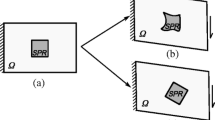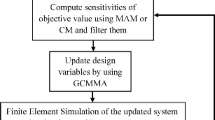Abstract
For a structural system composed of functional components in a vibration environment, it is of great importance to suppress the dynamic war** deformation of these local regions to ensure the performance and functionality of the system. Especially for a vibrating structure under a resonance response with critical deformations, such dynamic shape preserving design (SPD) problem is addressed to maintain local performances using topology optimization in this paper. The structure is assumed to be linear and elastic, with Rayleigh dam**, and subjected to a time-harmonic external excitation with a resonant frequency. The elastic work describing the maximum strain energy in a vibration period is defined to quantitatively measure the extreme war** deformation of local functional components. A normalized constraint on local elastic work is further introduced into a dynamical topology optimization model while maximizing the first-order eigenfrequency. Moreover, to preserve the outlines of void regions (e.g., openings), a dynamic artificial weak element (AWEdyn) technique is proposed to help measure and suppress the local deformation of voids. Numerical tests show that the dynamic elastic work could accurately describe the deformations of resonance structures. The effects of shape preservation are successfully achieved through topology optimization by suppressing war** deformations in subdomains.















Similar content being viewed by others
References
Andreassen E, Ferrari F, Sigmund O, Diaz AR (2018) Frequency response as a surrogate eigenvalue problem in topology optimization. Int J Numer Methods Eng 113:1214–1229. https://doi.org/10.1002/nme.5563
Bathe KJ (1996) Finite element procedures. Prentice-Hall, Englewood Cliffs
Bendsøe MP (1989) Optimal shape design as a material distribution problem. Struct Optim 1:193–202. https://doi.org/10.1007/BF01650949
Bendsøe MP, Kikuchi N (1988) Generating optimal topologies in structural design using a homogenization method. Comput Methods Appl Mech Eng 71:197–224. https://doi.org/10.1016/0045-7825(88)90086-2
Castro MS, Silva OM, Lenzi A, Neves MM (2018) Shape preserving design of vibrating structures using topology optimization. Struct Multidisc Optim 58:1109–1119. https://doi.org/10.1007/s00158-018-1955-x
Cimrman R, Lukeš V, Rohan E (2019) Multiscale finite element calculations in Python using SfePy. Adv Comput Math 45:1897–1921. https://doi.org/10.1007/s10444-019-09666-0
Clough RW, Penzien J, Griffin DS (1995) Dynamics of structures. Computers and Structures, Berkeley
Delissen A, van Keulen F, Langelaar M (2020) Efficient limitation of resonant peaks by topology optimization including modal truncation augmentation. Struct Multidisc Optim 61:2557–2575. https://doi.org/10.1007/s00158-019-02471-9
Du J, Olhoff N (2007) Topological design of freely vibrating continuum structures for maximum values of simple and multiple eigenfrequencies and frequency gaps. Struct Multidisc Optim 34:91–110. https://doi.org/10.1007/s00158-007-0101-y
Eldred MS, Venkayya VB, Anderson WJ (1995) Mode tracking issues in structural optimization. AIAA J 33:1926–1933
Fang Z, Zheng L (2015) Topology optimization for minimizing the resonant response of plates with constrained layer dam** treatment. Shock Vib 2015:376854. https://doi.org/10.1155/2015/376854
Kim TS, Kim YY (2000) MAC-based mode-tracking in structural topology optimization. Comput Struct 74:375–383. https://doi.org/10.1016/S0045-7949(99)00056-5
Li Y, Zhu JH, Zhang WH, Wang L (2018) Structural topology optimization for directional deformation behavior design with the orthotropic artificial weak element method. Struct Multidisc Optim 57:1251–1266. https://doi.org/10.1007/s00158-017-1808-z
Li Y, Zhu J, Wang F, Zhang W, Sigmund O (2019) Shape preserving design of geometrically nonlinear structures using topology optimization. Struct Multidisc Optim 59:1033–1051. https://doi.org/10.1007/s00158-018-2186-x
Liu H, Zhang W, Gao T (2015) A comparative study of dynamic analysis methods for structural topology optimization under harmonic force excitations. Struct Multidisc Optim 51:1321–1333. https://doi.org/10.1007/s00158-014-1218-4
Ma ZD, Kikuchi N, Hagiwara I (1993) Structural topology and shape optimization for a frequency response problem. Comput Mech 13:157–174. https://doi.org/10.1007/BF00370133
Ma Z-D, Kikuchi N, Cheng H-C (1995) Computer methods in applied mechanics and engineering topological design for vibrating structures. Comput Methods Appl Mech Eng 121:259–280
Niu B, He X, Shan Y, Yang R (2018) On objective functions of minimizing the vibration response of continuum structures subjected to external harmonic excitation. Struct Multidisc Optim 57:2291–2307. https://doi.org/10.1007/s00158-017-1859-1
Olhoff N, Du J (2014) Structural topology optimization with respect to eigenfrequencies of vibration. In: CISM advanced course. pp 275–297
Pedersen NL (2000) Maximization of eigenvalues using topology optimization. Struct Multidisc Optim 20:2–11. https://doi.org/10.1007/s001580050130
Picelli R, Townsend S, Kim HA (2018) Stress and strain control via level set topology optimization. Struct Multidisc Optim 58:2037–2051. https://doi.org/10.1007/s00158-018-2018-z
Shu L, Wang MY, Fang Z, Ma Z, Wei P (2011) Level set based structural topology optimization for minimizing frequency response. J Sound Vib 330:5820–5834. https://doi.org/10.1016/j.jsv.2011.07.026
Silva OM, Neves MM (2020) A strategy based on the strain-to-kinetic energy ratio to ensure stability and convergence in topology optimization of globally resonating one-material structures. Int J Numer Methods Eng 121:3636–3659. https://doi.org/10.1002/nme.6374
Silva OM, Neves MM, Lenzi A (2019a) On the use of complex input power in topology optimization of one-material vibrating structures for obtaining displacement anti-resonances close to frequencies of interest. In: EngOpt 2018 proceedings of the 6th international conference on engineering optimization. Springer, pp 829–843
Silva OM, Neves MM, Lenzi A (2019b) A critical analysis of using the dynamic compliance as objective function in topology optimization of one-material structures considering steady-state forced vibration problems. J Sound Vib 444:1–20. https://doi.org/10.1016/j.jsv.2018.12.030
Silva OM, Neves MM, Lenzi A (2020) On the use of active and reactive input power in topology optimization of one-material structures considering steady-state forced vibration problems. J Sound Vib 464:114989. https://doi.org/10.1016/j.jsv.2019.114989
Svanberg K (1987) The method of moving asymptotes—a new method for structural optimization. Int J Numer Methods Eng 24:359–373
Svanberg K (2002) A class of globally convergent optimization methods based on conservative convex separable approximations. Society for Industrial and Applied Mathematics, Philadelphia
Takezawa A, Daifuku M, Nakano Y, Nakagawa K, Yamamoto T, Kitamura M (2016) Topology optimization of dam** material for reducing resonance response based on complex dynamic compliance. J Sound Vib 365:230–243. https://doi.org/10.1016/j.jsv.2015.11.045
Tcherniak D (2002) Topology optimization of resonating structures using SIMP method. Int J Numer Methods Eng 54:1605–1622. https://doi.org/10.1002/nme.484
Wang F, Lazarov BS, Sigmund O, Jensen JS (2014) Interpolation scheme for fictitious domain techniques and topology optimization of finite strain elastic problems. Comput Methods Appl Mech Eng 276:453–472. https://doi.org/10.1016/j.cma.2014.03.021
Yang X, Li Y (2014) Structural topology optimization on dynamic compliance at resonance frequency in thermal environments. Struct Multidisc Optim 49:81–91. https://doi.org/10.1007/s00158-013-0961-2
Zhao J, Yoon H, Youn BD (2019) An efficient concurrent topology optimization approach for frequency response problems. Comput Methods Appl Mech Eng 347:700–734. https://doi.org/10.1016/j.cma.2019.01.004
Zhu J, Zhang W, Beckers P (2009) Integrated layout design of multi-component system. Int J Numer Methods Eng 78:631–651. https://doi.org/10.1002/nme.2499
Zhu J, Li Y, Zhang W, Hou J (2016a) Shape preserving design with structural topology optimization. Struct Multidisc Optim 53(4):893–906. https://doi.org/10.1007/s00158-015-1364-3
Zhu JH, Zhang WH, **a L (2016b) Topology optimization in aircraft and aerospace structures design. Arch Comput Methods Eng 23:595–622. https://doi.org/10.1007/s11831-015-9151-2
Zhu J, Li Y, Wang F, Zhang W (2020a) Shape preserving design of thermo-elastic structures considering geometrical nonlinearity. Struct Multidisc Optim 61:1787–1804. https://doi.org/10.1007/s00158-020-02532-4
Zhu J, Zhou H, Wang C, Zhou L, Yuan S, Zhang W (2020b) A review of topology optimization for additive manufacturing: status and challenges. Chin J Aeronaut. https://doi.org/10.1016/j.cja.2020.09.020
Acknowledgements
This work is supported by Key Project of NSFC (51790171, 51761145111, 51735005) and NSFC (11725211).
Author information
Authors and Affiliations
Corresponding author
Ethics declarations
Conflict of interest
The authors declare that they have no conflict of interest.
Replication of results
The topology optimization procedure was developed on a Python platform, using the MMA algorithm. The FEM problem is also solved in Python. Other finite element solvers can be alternatively used to carry out the shape preserving design proposed in this paper. The open-source MMA optimization algorithm accomplished by Professor Krister Svanberg from KTH Royal Institute of Technology is recommended. Fortran and MATLAB versions are available. We have verified the finite element results and functional sensitivities of a simple structure with other commercial finite element software and the Fortran version MMA, and the same results were obtained. We are confident that sufficient details on methodology and implementation are contained in this paper, and readers who have difficulties and questions to replicate the results are welcome to contact the authors.
Additional information
Responsible Editor: YoonYoung Kim
Publisher's Note
Springer Nature remains neutral with regard to jurisdictional claims in published maps and institutional affiliations.
Rights and permissions
About this article
Cite this article
Wang, YL., Zhu, JH., Li, Y. et al. Shape preserving design with topology optimization for structures under harmonic resonance responses. Struct Multidisc Optim 65, 145 (2022). https://doi.org/10.1007/s00158-022-03218-9
Received:
Revised:
Accepted:
Published:
DOI: https://doi.org/10.1007/s00158-022-03218-9




